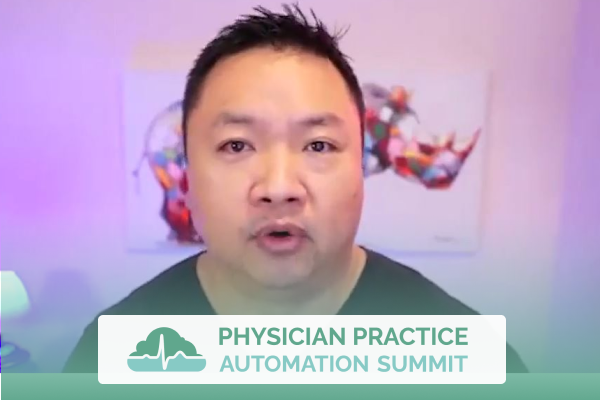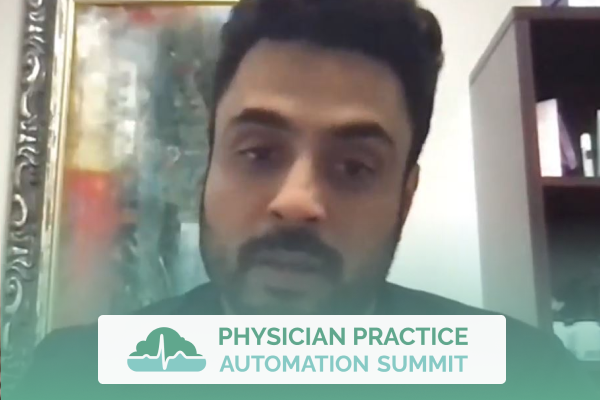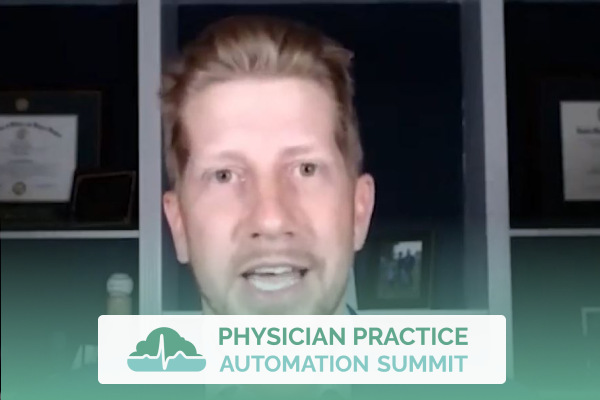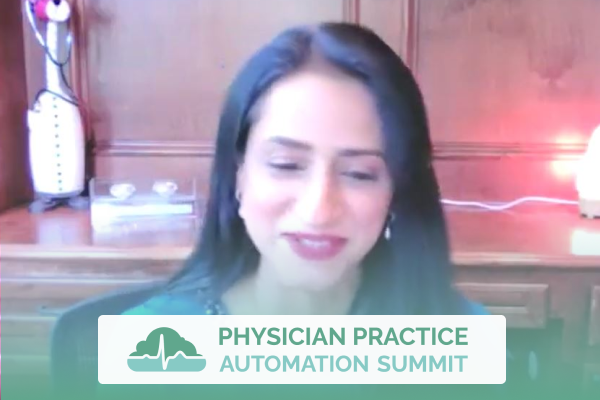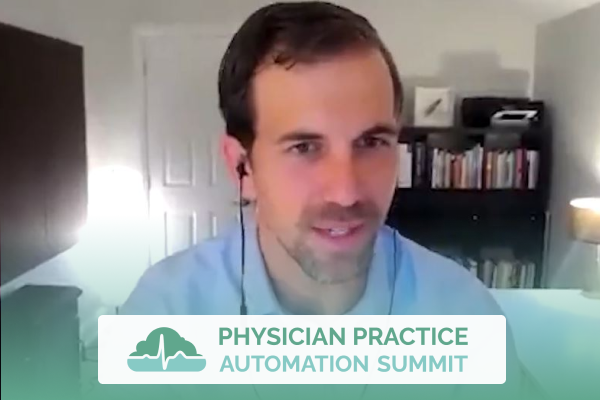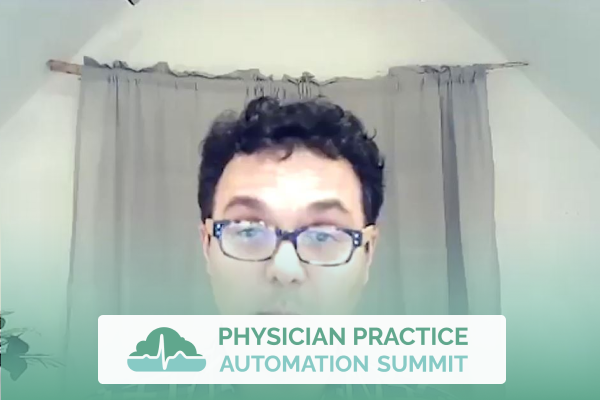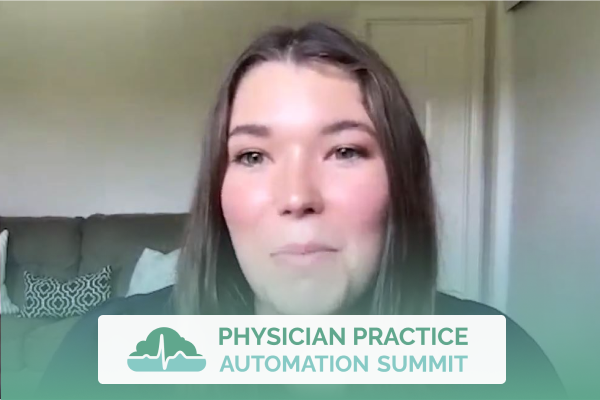Join the discussion below
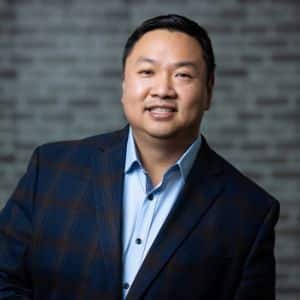
Dr. Ruan is the Founder and CEO of Texas Center for Lifestyle Medicine. He devotes his career in practicing and building systems that allow for efficient delivery of healthcare. He is a board certified internal medicine physician but also have advised with companies to improve their workflow, company culture, marketing,... Read More
Cheng-Huai Ruan, M.D.
So Dr. Murilio* on the last segment just talked about culinary medicine as spectrum health. But what are the components we actually need to cultivate together a really good program? So this segment I’m talking alone. I’m gonna be covering what are the components that are needed for the culinary medicine program that you may want to create for your audience? So let’s define a culinary medicine program, I know Dr. Leann Morilio talked about it at the last segment, but it is literally teaching every aspect around the cooking process. So some people think it’s just food. No, it’s not just food is the preparation. It’s allocation of costs it’s making sure that you’re getting good nutrient density foods in. So it’s food education that’s involved there.
There are talking about kitchen safety, where to store things. If your kids don’t kids don’t play with the knives and stuff like that. There’s talk about fire safety. If there’s a gas stove and making sure that there’s safety protocols around the home for it as well. So you see it’s far more involved than just talking about the food aspect or the cooking aspect. And the culinary medicine program, that’s very different than let’s say like a cooking show, a cooking show, you know, features all sorts of food and stuff like that, which is part of the program. But once again, the culinary medicine design is for more of an educational interaction portion as well. So here’s what I think that are needed as a, in terms of what it should really look like.
Now there’s a lot of other facilities that have culinary medicine, other than Spectrum Health. You have Stanford of course, you have the Ulcer Integrative Health Program at Northwestern in Chicago. Baylor College of Medicine has a version of their cooking kitchen as well. So that you see it’s, it’s already been done at larger institutions, but today we’ll tell you how we can do it at a smaller institution, even in private practice. So it can be automated and scalable. That’s what the summit’s all about. So I think what it really needs to look like is that there’s a kitchen space and the kitchen space doesn’t necessarily have to have burning ovens and stuff like that, it really depends on the course.
For example, if you’re doing a course on creating a nice salad combinations that doesn’t necessarily require cooking, it doesn’t really have to have a heat element. But if it did, then that’s pretty easy because you have now portable induction tops that are very inexpensive, $35 to $85 induction tops that you can have. That you can just just plug in and go. And induction tops are great because even if it’s on, your hand touches, it can’t feel the heat. They only transfers it to an induction cooking device. And the induction cooking device transfers that energy into the pot or the pan or whatever it is. So you see it can be done relatively cheaply. But let’s take the, let’s take, put some effort into who are the components that are, that are needed to run the program. So you can find chefs, you can find kitchen spaces, you can find other dieticians to work with.
If you don’t have one on, on your own, you can find area doctors that are willing to funnel people into the program. And so while it might sound complicated, let’s break everything down step by step. Okay. So let’s start with the fundamentals, which is that you need at least a kitchen space. So if we’re thinking about it right now, we’re in the pandemic. And if you think who, which restaurants are going to have kitchen spaces available, actually, it’s probably going to be a lot of them. But I want to, I want you to focus on decreasing costs because there’s restaurants that have kitchens that are in warehouses and why would they be in warehouses? It’s because they’re, they’re cooking in large quantities for other restaurants or for their own main restaurants. And those warehouses are designed to be very ergonomic, right?
And what I recommend is starting with a concept called virtual culinary medicine, where you set up cameras and lights and you broadcast from that warehouse kitchen. So warehouse kitchens typically shut down in the evening time because they prepare a lot of stuff that’s pre-prepared and deliver to restaurants throughout the day. So in the evening time you can say, Hey, Mr. or Mrs. So-and-so who owns this warehouse kitchen, I would love to see if we can rent your space in evening time, and you’re not using it anyways, maybe 6:30 PM, 7:30 PM. And so in that block of time then becomes that business owners, revenue generator. And so you can negotiate a price for those, you know, two hours blocks of times. And then you can also talk to them about, Hey, can we use some of your kitchen material, do you have any chefs that want to be involved in this?
And you know, you’d be surprised to learn that a lot of people really want to get involved in something like this, because it’s a passion of a lot of people. When you put yourself out there, you’ll, you’ll find them. And so if there are people involved, you’ve got the kitchen. And then if you talked to the owner, you have the materials, you have the chefs, and see if that kitchen owner will help you get your resources like the food resources as well. Because they’ve access to, to, you know, wholesale pricing and markets and stuff like that. But if not ask the, ask the owner, if you they work with any local suppliers or even area farms, area ranches, anyone that can sort of produce the produce that you are utilizing on the, your culinary medicine demonstration.
Now, this is really good for small local area farms and distributors and suppliers is because they actually get exposure too. So you can talk to them like, Hey, are you willing to donate some food for this demonstration? And you can even invite them on to learn about where the food comes from. If it’s a carrot, like how much love goes into this carrot that they’re cooking with and learning about phytonutrients from planting all the way to growing all to watering and nutrients and stuff like that. It really connects people with the food. And so if you have those elements, the food supply, if you have the equipment from the restaurant or the test kitchen, and then if you got the chefs and then the last two elements is form an insurance billing perspective. What you really want to focus on are those CPT codes that are actually new for 2020.
Which are the behavioral modification CPT codes. So these are 96156 for an assessment, like a questionnaire and 96158. That’s only if you’re demonstrating to one person because that’s a one-on-one, but there’s 961, 96164, which is actually the, the CPT code for group coaching sessions per interval time. And so there, so if you look at some of those codes and these things change all the time, we’ll go ahead and look, just Google them, look them up on the American Medical Association, CPT sites, and look at the components of the code. What you’ll see, these are behavioral modification strategies that are dedicated to some sort of disease state, some sort of IC 10 diagnosis. And the people who can deliver that are what’s called non physician qualified healthcare professionals, or NPQHC’s, the non-physician qualified healthcare professionals are people who are not physicians, but they have their own provider ID and NPI number.
So this could potentially be a dietician that comes on board, a social worker, a NP, a PA, or someone of that nature. Right. And so that person can be the moderator for that session. What I recommend is because we’re doing this virtually that person should probably be on the same virtual conference so they can moderate the actual room. It’s a lot easier for them to be on there virtually to moderate the room than it is for them to be in person at the kitchen, with the chefs and trying to talk into the camera.
It’s very distracting. Okay. And so you have your non-physician qualified health care professional, and they’re really rendering the actual service. And they’re interacting with the chefs. They’re interacting with the people who are streaming on and engaging them on the education portion. Alternatively, the chef him or herself can actually probably also be the non-physician qualified professional. Let’s say if someone who’s demonstrating is actually the dietician him or herself. And then in that way, it kind of covers everything.
So there’s a lot of ways to do it. But the minimum components is that you need someone to teach the cooking and demonstrate the cooking or cooking technique. And then you need someone in there to deliver the actual behavioral change modification for a chronic disease state. Which is going to be that provider that non-physician qualified health care professional. Okay. Alternatively, can you have physicians in there as well? Yes. A lot of doctors really want to get involved in the process as well. So you have your non-physician qualified health care professionals, rendering the service or the doctor rendering the service, and then that’s on the actual live feed. It could be Zoom. It could be whatever you choose to be. And then you have, and then you have the, and then you have the patients.
Now, the patients are going to come from your practice. And so obviously this is what we call a virtual or digital digital medicine that’s delivered. So while we use the collectively as telemedicine, a lot of insurance companies want you to document it as a real-time audio and visual live connection with the patient that’s delivered. So that’s really the terms that a lot of insurance companies are looking for. You know, trust me the term, telemedicine just doesn’t fly and can get denied in some instant claims. We’ve done this before at Texas Center for Lifestyle Medicine. So you have the patients coming on to the live feed. You have the provider coming on to the live feed, and then you have the actual chef or the demonstrator that’s in the test kitchen. And the last component that you’ll need will probably be some sort of a medical assistant.
Why? Okay, so remember these are still provider visits. So the medical assistant can take care of things that people have in the background and more administrative things such as if they want the recipe that we’re covering during the session or they want other resources that are there. The medical assistants can handle that. But let’s say that someone types in the chat and this always happens, someone will type in the chat. Hey, you know, by the way I actually, I’m running out of this, this medication.
And so of course this cooking session is not, not set up for things that happen like that, but you still need the support of someone there that say, Hey, you know what, in the morning we’re gonna take care of this. Right? And, you know, before when we used to do something, that’s relatively similar. We didn’t really have a medical assistant there. And these things will come up all the time. And it becomes very, very distracting. Okay. So that medical assistant can type in the chat box, say, Hey, we’re going to take care of it. Or come online and say, we’ll take care of it in the morning.
So that medical assistant can really capture a lot of the medical stuff that’s needed to be taken care of maybe later on. And that’s just the more I like to call it an over delivery of value to the, to the patients like they have that sort of safety net as well. So the administrative task burdens that are there. That same medical assistant can also be in charge of sending things out beforehand and some, and then, listen, let’s talk about more about the insurance side. So that medical assistant can also make sure that if the CPT codes are hitting the patient’s deductibles, then they will want to collect beforehand before they come onto the, the visit.
And I hope they do that for, for everything that you do in your practice as well. Cause collecting beforehand for deductibles is a very important thing. Or is there a copay, is there an 80 20 split between the insurance company or the patient? So those things have to be figured out first from a prior verification process and then collections prior to them coming on to the actual virtual platform. And then you have a delivery of the care that’s right there. And that medical assistant is also probably going to be responsible for consents. So another portion of the summit, and you talk with Scott Rat again, he’s a lawyer, a functional lawyer, and he talks about yes, there’s components that are needed for medical practices. And if you’re doing things a little bit outside the box, you want to be able to create a consent to treat for that.
So you can create consent to treat saying that, Hey, this is what we’re going to do, this is a, this is culinary medicine is not designed to prescribe medicines, designed to prescribe techniques in lifestyle and behavioral changes. And these are the codes that we’re going to be using. It’s really important to get, give patients to CPT codes that you’ll be using like the 96156 and the 96164 and 96165, which is actually additional increment minutes. So those are just examples. So these are the codes that we can be potentially using for, for this particular program. Okay. And so, and by the way, I mentioned those codes because those are probably the most descriptive codes, CPT codes for the culinary medicine program, but there actually can be others as well. So now they have the medical assistant do a lot of administrative background work and there needs to be handoffs and standard operating procedures when this happens as well.
So we’re basically kind of reverse engineering it, right? So we talked about the test kitchen, the elements of the test kitchen. We talked about the people, the patients coming in, the dietician or the qualified or the non-physician qualified healthcare professional. And then we talked about the MA. Now let’s go back a little further and say, well, how do the patients get here in the first place and it’s prescription. So ideally you want to be able to prescribe culinary medicine for the patients to come into the actual event.
So you want to see it almost like a, like a consultative efforts. So what are the insurance companies trying to look for to, to, to make sure that you get everything covered? What they’re looking for, are documentation of medical necessities, is there a medical necessity for the patient to receive this type of CPT service, right? And the documentation medical necessity is very easy. All you have to do is document that this patient’s medically necessary for this program because of X, Y, and Z, usually dealing with a chronic disease state. So let’s say they’re diabetic. You say, Hey, we want to hit a goal A1C from, you know, 7.7 down to 5.5. And part of this process is this culinary medicine program. Or let’s say the patient has auto-immune disease.
And every time the patient eats a lot of sugar or, or wheat products, and they’re under arthritis, rheumatoid arthritis, flares up, you can say, you can, you can talk about the document necessity of clean eating and healthy, healthy habits to modify which disease state, is there rheumatoid arthritis or whatever autoimmune disease process they have. Same thing with irritable bowel syndrome. Some people, some people have a lot of gut issues and they clean up their diet, it can be taken care of. Same thing with memory loss. That’s a big one. So those people who have mild cognitive impairment and memory loss, a lot of times they’re elderly and sometimes they’re living alone, but they’re with it enough to get onto a zoom or something like that, and be part of the interaction.
And so a lot of these people don’t have any resources. So for them to, to be interacting with the kitchen, our test kitchen is actually pretty, pretty marvelous as well. You know, so, and I can’t tell you how, how often the elderly are the people who really are the most driving and engaging people within a virtual telemedicine course, or a platform. And then kids. And so, you know, I’m in sort of medicine. I don’t really see a whole lot of kids, but my partner is family medicine and she sees some. And so the kids are really important because childhood obesity is a big deal. So when you have a kid into there, you got to make sure that the parents are the one that are in there and consenting, and that the parents actually have their own log-ins into the, into the zoom.
So your medical assistants, what they may need to do is to have the parents, when they log into zoom, label their zoom name as the child’s name. And if you actually record these sessions, then you can go back and see who has come in and who hasn’t. So that’s one little caveat I forgot to mention earlier. And so, but yeah, childhood obesity is a huge deal. It’s a humongous deal, but a lot of kids, a lot, especially a lot of teenagers when they come into like this culinary medicine program, they like to, it really, it kind of opens their eyes like, wow. You know, cooking is a lot easier. Preparing food is a lot easier and I can help my parents. And they feel very engaged with it as well. Plus for the first time they’re seeing where their food actually comes from, like these carrots come from the dirt, you know? And so that’s really important to be part of the engaging process with the children. But of course, also with adults as well.
All right so prescriptive medical necessity comes from some sort of an ENM visit that’s within the office, right? So that can be prescribed by a doctor or any other allied health professional into the actual program, depending on the insurance. And so the way I tell a lot of people to set this up is that in your electronic medical record, what you want to do is to set up depending on how your EMR actually works, set your own culinary medicine course out as a referral provider, or set it up as a procedure. So, that’s when this course is being delivered, that procedure can be satisfied in closed loop on it, or the referral can be satisfied. What you want to do is in your EMR, you always want to make sure that you actually close the loop.
So you can audit to see if this patient’s attending the culinary session, how many sessions they they’ve attended and whatnot. And also if you’re, if you’re also prescribing this as a procedure what you want to do is label every session, a different name. You want to label, you know, session one, we’re talking about salads or whatever. You want to label it different name is because you want to be able to make sure that each of these can be tracked. So when you go back into EMR and extrapolate inquiry in, come out with this data, you can see how many sessions they’ve been to. You can see what they’ve already done, right? And so that will give you plenty of data to say, Hey, this patient’s A1C went from 9.6 down to 6.2 in three months. And this patient went from 9.2 down to, well only 9.0. Well, this patient’s in one session.
And the previous patient attended all eight sessions. And then now you now have cases to look at because data is key, right? So that is clinical data that you want to be able to make sure that you always measure. When insurance companies they look at these things and they start denying things, one of the reasons is because you don’t have data, believe it or not. If you have data showing that, Hey, our patients are getting their A1C reductions this far without medications, and they’re doing these culinary sessions. You send that to the insurance company, the likelihood of them saying, okay, you’re doing well, pat you on the back, they won’t have any problems after that.
So, you know, a lot of practices don’t go after denials with data. But if you have data then you’re able to show that. So in our electronic medical record system, so we’re able to track it and then we’re able to send the data. Another piece of data that’s really important is patient reported, outcome data, PRO data. So patient reported outcomes. What is that? So the most common scoring system is called promise score. P R O M I S and PRO actually does stand for patient reported outcome data. So these are basically questionnaires that allow you to know the patient’s perception of their improvement in health. And these are heavily published as well. Just because it’s not objective data from a lab, doesn’t mean that it’s worthless, actually it’s worth quite a bit. And we know that because a lot of these questionnaires are correlated with morbidity and mortality as well. So you’re able to get your promise scores for the patients, and you can look this up, it’s available everywhere.
P R O M I S promise scores. If you able get your promise score for the patients and have them do these scores throughout the sessions. Now you have a valuable piece of data. And because you’ve labeled each of the sessions different names within your EMR, able to see who’s done, what, what progression they’ve had, sorry, what progression they’ve had and see the correlates with improved clinical outcomes. And I’ll tell you that they usually correlate with clinical outcomes and that’s the rewarding part behind it. And then you can utilize this data for your marketing efforts, as well as like, Hey, you know, in the last three months, the patients who have done our culinary programs with diabetes have this much reduction in the A1C. Whereas you can benchmark the county reductions A1C, which is usually not a reduction in A1C at all. Or you can benchmark medication.
You can say that, Hey, Metformin reduces A1C by about 1%, but look at our culinary medicine program, right? You can say that, Hey, Metformin, plus, you know, SGLT two inhibitor, one of those categories reduces A1C by 1.7 to 1.8%. But look at our data and this is what we’re doing. So benchmarking data against pharmacological data is a very attractive endeavor. And I recommend a lot of physicians kind of do it and go into it as well. All right. So we talked about how, from an administrative standpoint to do this, the MAs and we talked about the dietician, the patients, and we talked about the, the chefs as well. And we talked about insurance reimbursement as well. So we’re getting pretty deep into the administrative side of things, which is what I do. All right. So now let’s go back a little more and say, well, I want to be able to prescribe these things. How am I going to get my patients to actually show up to these things? Well, it depends on how you deliver the message, right? If you, if you say, Hey, I’m gonna prescribe you a culinary medicine program, it’s eight sessions and you hop on zoom. They’re going to freak out a little bit and say, whoa, first of all, what is Zoom? Second of all, what is the culinary medicine program? So the way that you deliver any, any sort of value to the patients, when it comes to prescriptive authority, you start with the end result that you really want to achieve.
And so you can say, Hey, Mr. Smith, gosh, I will, I would love to see your A1C down here, or I will love to see your HS CRP at this number. Or I will love to see, you know, your blood pressure at this number, but you know what, you know, pharmaceutical medicines, they haven’t been as effective and why not try something new? Or you can say that, Hey, you know, your goal is here, but you’re here right now. And there’s two ways to get to where you are. So if you look at the American Heart Association guidelines in reduction of dyslipidemia, the first 90 days is supposed to be a period of lifestyle modification called first-line therapy. If so the first line therapy should be diet and lifestyle modification.
So you can prescribe for that first-line therapy or diet and lifestyle modifications for these 90 days in these culinary medicine events. So it helps them prevent the patients from either getting on statins or whatever medication that they’re fearing to get on. And that’s going to help them really empower them because now the ball is in their court. You are the guide, and then now the ball’s in their court. And then from a guidance perspective, they’re going to appreciate you for it. But always start with the end data. And if you have data from before, you can utilize that data. And if you have data from other facilities like Spectrum Health, then you can also utilize that data as say, Hey, these, these people in Michigan are doing this, and this is what they’re doing. This is their outcomes.
We’re, we’re actually doing the same thing. Do you want to participate? So use other people’s data, use published data, use unpublished data as well, because data doesn’t necessarily have to be published in the peer review journal, a form of lifestyle medicine program. It could be data from what I’m talking about for you here, you know? And so, and so start with the end results, start with the data and that you want to help your patients achieve. And they’ll love you forever. And they’ll be super compliant with the actual program. So we talked about prescribing the patients this culinary medicine program and how to talk about it. Now you’ve got to get your entire office staff involved as well. So we talked about the medical assistant being part of that process, but what’s going to happen? And this happened to us is that people are going to find out what you’re doing. They were like, whoa, this is cool. They want to get their family members on board.
They want to get their friends on board. There’s really close knit populations within the community and Facebook forums like cancer survivors and stuff like that that are going to be involved and wanted to come on. And someone will recruit literally 10 of their friends say, Hey, we, all of us want to do this, calling about some program. You can recruit them as patients, stuff like that. So from the marketing side, it becomes a really good lead magnet. And lead magnet is a marketing term, just that you’re magnetizing something that you’re already doing. And the patients are the ones that’s being magnetized to you. So it’s called a lead magnet. And so what happens is you, you create this, you create this, this excitement, that’s there. You want to get your staff to really share in it. You want to get your schedulers to know what you’re doing so that they’re able to schedule appropriately. So let your schedule is let us know, Hey, these programs are only for established patients because we are billing this through insurance. And or acquire either a face-to-face or telemedicine visit first, depending on where we’re in the country you are Florida, for example, you’re a Florida licensed in Florida, telemedicine licensed, and you don’t really need an in-person visit. So these things change all the time, as well.
I’m in Texas, we still need to establish some sort of inpatients in-person visits and then do telemedicine after that. So that’s your scheduler. And then your administrators have to be involved and your billers have to be involved. And your billers and administrator needs to talk to each other about how things are going to be done. So your administrators need to know that your MA or front desk or back office is going to be collecting money ahead of time. If there’s a deductible or copay or something like that. But the administrator would really needs to set up a private verification process for the CPT codes, because if you don’t, it becomes a big mess after the actual visit. So if you do have the CPT codes, if you, if you pre verify the CPT codes, now you have absolute certainties that, Hey, this is your out of pocket.
This is covered and stuff like that. And that’s true for all group visits, all group visits. You should really be doing that because if you take, try to take care of it afterwards, it becomes an administrative nightmare. Trust me, because I’m an administrator, right? And then your billers have to be on board. So your billers have to look for claims submissions and denials. And then look at, Hey, which insurance is denying this, why are they denying it, are they looking for particular documentation that is needed? What are they literally looking for? So if you’re billing out these CPT codes like 96164, which is lifestyle, behavioral modification code, then are, is there enough documentation for, let’s say, you know, Cigna to support this, right? And so, because insurance companies are actually looking for different documentation it becomes a little hard. But the easiest thing to do is to look at the definition of the CPT code and use the actual definition into your documentation. So this is a health behavior assessment and treatment plan. That’s describing a CPT code. Then you better put that this culinary medicine program is designed for the health behavior modification and treatment of X disease, right? And that’s the easiest way to get your claims to go through on, on first submission.
But if it does get denied, you want to know why, when in the frequency of denial. Not only that you also want to know what each of the fee schedule is for insurance getting paid. So you have some sort of predictive analytics that are there as well. So we have the luxury of using this company called Jensen Health. They’re our revenue cycle management company. So they have artificial intelligence that literally predicts all this. And they’re very inexpensive. And it’s been there, one of my partners on trying to create systems and strategies to have predictive analytics on how to create programs, such as like culinary medicine program. We also have a mind body medicine program, functional nutritional program as well. And so I can’t tell you how important predictive analytics is, is just, is just a very, very important thing. And so we, so you want to know more about Jensen.
They actually do a free assessment of your entire clinic. I will have that link in the description of this video as well. So, and then, how do you, how do you get patient? How do you get patient buy-in after prescribing? So I talked about prescribing this talked about documentation and talked about you start with the end result that you’re trying to achieve, and you tell them the patient, the purpose behind it and the national prescribing, right? So there’s still going to be a disconnect between the patient being prescribed. Cause they’re going to be gung ho on getting day one. They’re going to go, they’re going to go back home and say, I don’t know if I really want to do this and can get kind of nervous. I don’t know really what to expect. And so it’s a really good idea to do a mock a demo of your cooking sessions and have it on YouTube, have on some were put on your website and say, Hey, this is actually what it’s going to be like. And have people have fun within that mock session. It could be your staff, it could be your family and just, just do a test pilot, just do a pilot run and record the thing.
And there’s any points of like funniness or laughter or anything that shows people smiling. That’s what gets people excited. And then I can’t tell you how often that really helps. It helps tremendously. That way people can visualize and see and know exactly what they’re expecting. Now, if you’re, you don’t want to do that, then at least write out what to really expect, how the behaviors of engaging with the chef or the questions that people, you know, most frequently asked questions that people have that are engaging with the chef or the dietitian or whoever is the non-physician healthcare professional, or the doctor that are, that are in there. And so it’s basically like a little, like maybe like a one sheet playbook that you have for the patients. Or you can have both, you can have a one sheet playbook, plus you can have a video of, of a mock demonstration. That’s going to provide a lot of patient buy-in. The last thing I’m going to cover are audio and visual. And lights, A V and L, audio visual and lights.
So this is actually relatively inexpensive these days. So from the lighting perspective, what you’ll have to do is set up some sort of what I recommend are at least three lights, right? Actually I have a right here. So over here I have a light. Over here I also have a light and I have a little light here. That’s really just to highlight my hair. That’s a little aesthetics and I have one that’s behind me right here as well. So I will recommend doing the three point lighting setup. I don’t, I’m not going to go into what this is. You can Google it, go on YouTube. Look at three point lighting setup. It’s actually really, really easy. Okay. And the lights are inexpensive. I recommend using led lights. I don’t recommend using bulbs. LEDs.
Why is because if you use non LED bulbs, it gets really hot into that room. Okay. And then, and then now your chef is sweating and we don’t necessarily want to do that. It’s not the most appetizing thing in the world. Been there, done that didn’t like it. So those are the, just look at the three point lighting system. Like I said, very, very easy to set up 1, 2, 3, boom. You’re done. Okay. And then the other thing to think about is the audio and the camera. There’s a lot of microphones that you can put on the table, but it gets in the way. So for example, I have this blue mic right here. It may or may not be something that you want to use, and I’ll tell you why is because whenever the chefs starts like clinking and cooking and stuff like that, it doesn’t have enough good noise cancellation, unless you’re using a software to do it, to cancel that noise. So it becomes really like, you know, jarring to the ears where you really want to do is use something called a lavalier mic. I think I have one here. Thought I did. A lavalier mic basically is one of those things that you can kind of clip on right here. And there is, there are new ones out that there’s no wires and all it is is little clip on and it attaches to, sorry, it connects wirelessly to a camera or a Bluetooth. And so then we’re also probably going to need a tripod or, and a camera. And so, and, and a computer, of course.
So I don’t recommend using like a laptop and then doing the camera on the laptop, because then you can’t move the camera to some angles. And sometimes you want to be able to, the chef may want to be able to show you exactly what we’re doing and the chef, maybe you just want to be like, Hey, I’m going to adjust my camera angle down. Here’s what I’m actually doing. Right? So, and so that becomes a little tricky. So we really want to do is to have a camera that is mounted to an arm that’s on the table. So for example, this mic right here is on an arm onto my table. And so this is actually clamped to my table right here. And we can ask the same set up on the kitchen table as well. Okay? So instead of the mic being here, you can actually have cameras being here. And that way you can kind of move it around, or if you have a, a tripod and a tripod extends up and then the camera can be mounted onto a swivel point in that camera can that in that camera can swivel up and down left and right.
So there’s a lot of tools that are, that are for this as well. And then, and make sure you have good internet. So if you’re using a computer, ideally you want to use a wired internet and the wifi is fine. And you know, it really depends on the technology, but I can’t tell you how important it is to run a speed test before you start. What is a speed test? A speed test is if you go into Google and you type speed test, it will. And then the first thing that pops up is something that you hit start and it literally test speed of your internet. You want to make sure it’s fast, right? You want to make sure that download the upload speeds are relatively fast, you know, upload, you know, at least at least 25 megabytes, and then download it at least 82 to a hundred. Okay? These are actually relatively fast, but it’s becoming more, more, more common these days to have those download upload speeds. So, but even if you don’t get those speeds, you just want to test it, do a whole test session, do a whole hour. And to see if the upload and download speed is actually adequate. And backups. If your internet goes out, you want to set your computer to back up to a hotspot.
I have my iPhone right here. I use a hotspot. So you want to make sure you can either buy it or rent a hotspot from your carrier, or you can utilize your phone’s hotspot as a backup for when or if, or let’s just say when, because something’s going to go wrong eventually, right. When the actual internet goes out. So those are just some, some of the things to really think about. Now, I’m just brushing the surface right here. But what I really want to do is create a whole online course for this. So I’m offering, we’ll be launching this online course shortly after this summit is over. And if you’re watching this on replay later on, it’s probably already live.
So that link will be sent to you in the, just in the description of this video as well. If you’re watching this live, usually we, we send links in the, in the body of the email. That’s what the, what the live video as well. And so those are just some of the elements and aspects of setting up a culinary medicine program that I, I touched on. But, you know, go ahead and sort of engage yourself to see that that’s something that you really wants to do. But if you go through the process that I just told you, it’s going to be a lot easier to take care of things in feedback. And so I want to thank you for listening to me. Let’s jump onto the next summit session. Thank you.
Downloads

